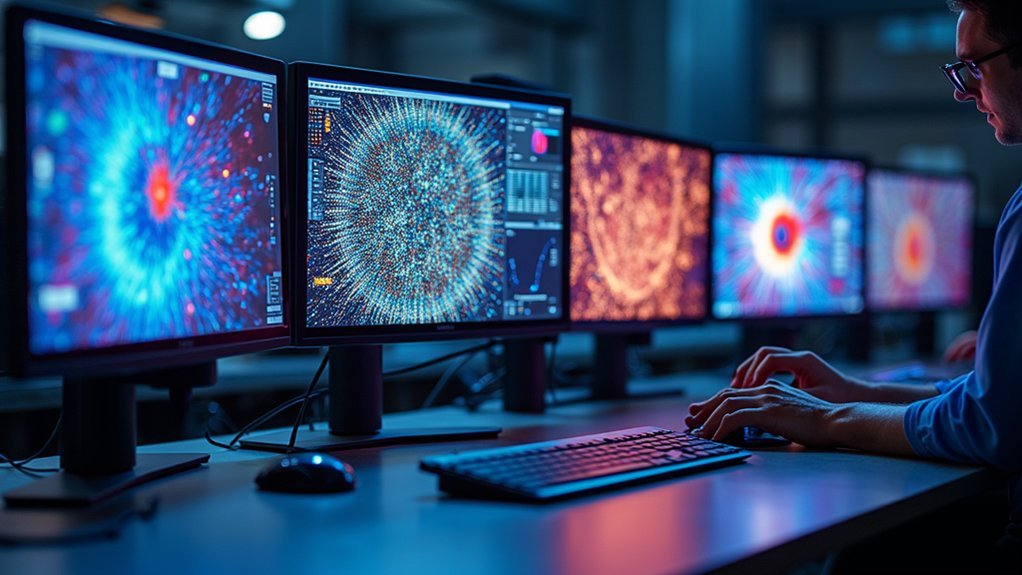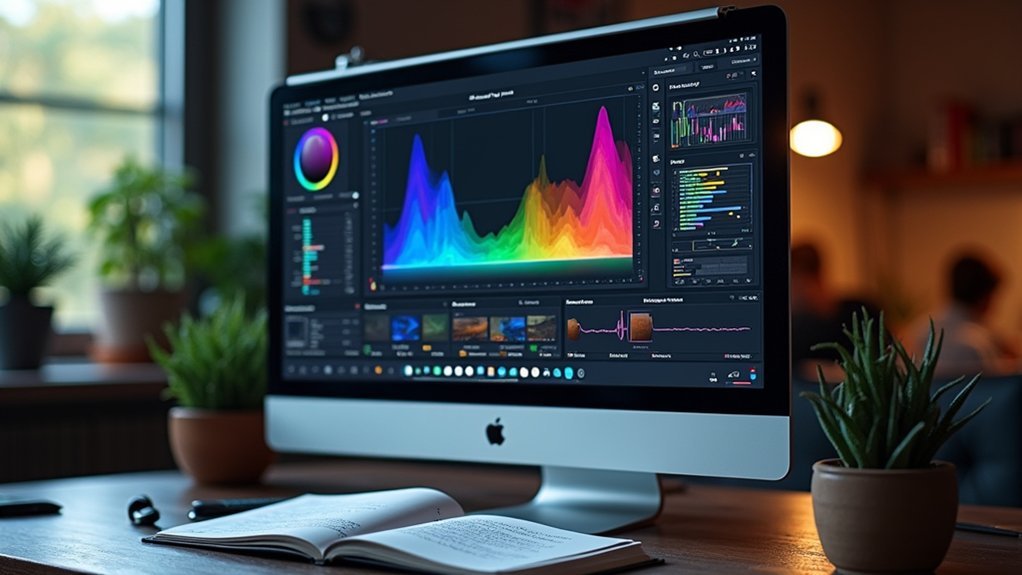Zerene Stacker stands as today’s premier image stacking software for microscopy and detailed photography, offering superior non-destructive retouching tools that preserve fine details. While Helicon Focus delivers faster processing speeds at a lower price point ($55/year vs. $189-289), professionals often prefer Zerene’s exceptional image quality and flexibility despite its steeper learning curve. Your specific needs—whether speed, retouching quality, or specialized visualization of birefringent materials—will determine which software truly shines for your workflow.
What Is The Best Image Stacking Software Today?
While the battle for supremacy in image stacking software continues to evolve, two major contenders dominate the landscape: Helicon Focus and Zerene Stacker.
Helicon Focus offers speed and high-quality outputs at $55 yearly or $200 for a permanent license, making it attractive for photographers needing quick results and effective noise reduction.
However, it lacks full contrast threshold control and has faced questions about reliability.
Zerene Stacker, widely considered the industry standard for focus stacking software, delivers superior image quality despite slower processing times.
Priced between $189-$289 (with a $39 student option), it provides extensive retouching tools and precise control over stacking parameters.
For complex projects requiring maximum detail and flexibility, Zerene’s robust feature set and exceptional customer support justify its premium positioning.
Top Polarized Microscopy Stacking Solutions in 2023
When choosing polarized microscopy stacking software, you’ll face a critical decision between specialist tools like Zerene Stacker and general-purpose programs like Photoshop.
While Helicon Focus offers speed and simplicity at $200, its destructive retouching workflow might require additional Photoshop work for professional results.
Zerene’s $289 Professional edition delivers superior retouching capabilities directly within its interface, eliminating the need for secondary processing and providing more control over your microscopy images.
Specialist Vs General Software
Although many photographers rely on general image editing software for basic stacking needs, specialized polarized microscopy stacking solutions offer significant advantages for scientific and macro photography applications.
When choosing a stacking program, you’ll find that dedicated options like Helicon Focus and Zerene Stacker provide superior results compared to general image processing tools.
Helicon Focus delivers quick results with its intuitive interface, making it perfect for preliminary quality assessment. Meanwhile, Zerene Stacker stands as the industry standard for ultimate image quality, offering extensive retouching capabilities and precise control over stacking parameters.
You can optimize your workflow by using both: Helicon for rapid preliminary stacking and Zerene for final, detailed processing.
Unlike general software, these specialized tools support various formats and camera models specifically designed for polarized light microscopy applications.
Retouching Quality Considerations
Since the final image quality heavily depends on post-processing capabilities, retouching tools have become a critical differentiator among top stacking software options.
You’ll find significant differences in how various stacking programs handle artifacts and detail preservation.
- Zerene Stacker excels with superior retouching capabilities, producing higher quality outputs with better noise control and natural saturation.
- Helicon Focus offers fast processing and user-friendly interface but includes destructive retouching tools that limit final image flexibility.
- Many professionals adopt a hybrid workflow—using Helicon for initial quality assessment followed by Zerene for detailed retouching.
- Retouching quality directly impacts your ability to extract fine details, especially in complex microscopy subjects.
When evaluating software options, prioritize retouching capabilities that match your workflow needs rather than focusing solely on processing speed.
Comparing Focus Stacking Features for Microscope Photography

Because microscope photography demands exceptional clarity and depth, choosing the right focus stacking software is essential for capturing minute details invisible to the naked eye.
When examining your options, you’ll find Helicon Focus offers rapid processing and an easy-to-use interface that won’t slow down your workflow.
Zerene Stacker, though, delivers superior image quality through its advanced stacking algorithm, making it the industry standard for microscopy work where fine details matter most.
While Helicon supports various image formats and processes quickly, it lacks the thorough retouching capabilities that Zerene provides.
Your choice ultimately depends on specific needs: if speed and user-friendliness are priorities, Helicon Focus works well.
For ultimate clarity and post-processing control in your microscope photography, Zerene Stacker’s advanced features make it worth the steeper learning curve.
Helicon Focus vs. Zerene Stacker for Polarized Specimens
When photographing polarized specimens, your software choice can dramatically impact final image quality and workflow efficiency.
Helicon Focus offers rapid processing and serves well as a preliminary screening tool, but lacks full control over contrast thresholds during B-stacks and has limitations with its destructive retouching tools.
Zerene Stacker, while slower initially, is considered the industry standard for extracting fine details from polarized specimens with superior output quality and extensive retouching capabilities.
- Helicon Focus prioritizes speed, making it ideal if you’re seeking quick results
- Zerene Stacker excels in quality and stability, particularly with complex polarized details
- Your workflow needs determine which tool fits best—speed vs. precision
- Consider using Helicon for initial assessment and Zerene for final, publication-quality images
Specialized Tools for Birefringent Material Visualization

Birefringent materials require specialized image stacking techniques that properly capture their unique optical properties when viewed under polarized light.
You’ll find that software like Helicon Focus and Zerene Stacker offer powerful platforms for visualizing these materials by merging multiple focal planes to reveal subtle variations in refractive indices.
These advanced visualization tools enable you to highlight intricate crystal structures and stress patterns that would otherwise remain hidden in conventional microscopy.
Polarization Technique Fundamentals
Light manipulation forms the core of polarization techniques, a specialized approach that reveals hidden details in birefringent materials through controlled light interaction.
When you’re working with transparent or seemingly featureless specimens, polarized light dramatically enhances contrast by exploiting the dual refractive indices these materials possess. Polarizing filters are essential tools that allow you to control light direction and reveal intricate internal structures otherwise invisible.
- The Michel-Levy chart helps you quantify observations by correlating colors with material thickness and refractive properties
- Compensators fine-tune the polarized light to highlight specific structural features
- Crystal orientation becomes visible through characteristic interference patterns
- Stress distributions appear as distinctive color gradients when properly illuminated
These fundamentals enable precise analysis across geology, materials science, and biological imaging applications.
Advanced Visualization Platforms
The exploration of birefringent materials requires sophisticated visualization tools that extend beyond basic polarization techniques.
Today’s advanced visualization platforms integrate polarized light microscopy with specialized software that enhances contrast and detail in your samples with exceptional quality.
You’ll find these platforms particularly valuable for quantifying birefringence patterns, revealing critical information about stress distribution and crystalline structures at high resolution.
Many systems now support multi-dimensional imaging, allowing you to observe how birefringent materials behave under various lighting conditions.
The 3D modeling capabilities integrated into modern platforms enable you to create thorough representations of optical properties, essential for detailed analysis.
Whether you’re working in materials science, biology, or geology, these visualization tools provide the precision needed for applications ranging from quality control to groundbreaking research.
Processing Speed and Performance Benchmarks
When selecting image stacking software for astrophotography, processing speed can make or break your workflow efficiency.
Performance benchmarks reveal significant variations among popular options. ASIDeepStack leads the pack, completing tasks in under 2 minutes, while PixInsight requires over 14 minutes for identical operations.
Deep Sky Stacker offers fast stacking capabilities that make it ideal for beginners who need quick results without complex features.
Meanwhile, AutoStakkert!2’s optimized code delivers processing speeds twice as fast as previous versions.
- Faster processing times allow you to stack more frames during a single session
- Quick feedback helps you adjust parameters more efficiently
- Reduced waiting time keeps you engaged in the creative process
- Software speed directly impacts your overall productivity, especially with large datasets
User Interface and Learning Curve Analysis

Beyond processing speed, maneuvering a program’s interface and mastering its functions directly impacts your stacking workflow. ASIDeepStack offers the most user-friendly experience, making it ideal if you’re just starting your stacking journey.
While Helicon Focus presents an accessible interface, you might find its retouching tools cumbersome for detailed images.
Zerene Stacker delivers extensive features but requires more time to master due to its complex parameter controls.
If you value efficiency, AutoStakkert!’s streamlined workflow lets you adapt quickly without unnecessary complications.
Remember that whichever software you choose, you’ll need to invest time learning its specific approaches and tools. Switching between programs later can be challenging as you’ll need to unlearn established habits to fully leverage new capabilities.
Advanced Retouching Capabilities for Microscopy Images
Microscopy image stacking demands precise retouching capabilities to preserve fine details while eliminating inevitable artifacts that emerge during processing.
Zerene Stacker excels with thorough retouching tools that help you achieve high-quality outputs without sacrificing detail integrity. Conversely, Helicon Focus offers rapid stacking but falls short with its destructive retouching approach, often necessitating Photoshop for final adjustments.
Zerene’s non-destructive retouching preserves crucial microscopic details, while Helicon’s speed comes at the cost of editing flexibility.
- Create and manipulate sub-stacks to focus on specific regions of interest—a vital feature missing in Helicon Focus
- Combine outputs from different stacking algorithms to effectively address stacking artifacts
- Maintain non-destructive workflows for maximum editing flexibility
- Extract fine details with precision for scientific and professional-grade results
The most effective microscopy workflow often involves using specialized stacking software for initial processing, then leveraging Photoshop’s advanced retouching capabilities for finishing touches.
Price-to-Performance Ratio of Leading Software Options

Selecting the right focus stacking software ultimately depends on balancing your budget against performance needs.
Helicon Focus offers an appealing price-to-performance ratio at $55 yearly or $200 for a permanent license, delivering faster processing and high-quality outputs, though occasional stability issues should be considered.
Zerene Stacker presents a tiered pricing structure ($39 for students, $189 for Prosumer, $289 for Professional) and while slower in processing, it’s regarded as the industry standard for image quality.
Its extensive retouching tools, stability, and superior customer support make it a potentially better long-term investment.
Your decision should weigh immediate budget constraints against your quality requirements—Helicon provides speed and affordability, while Zerene offers premium quality and reliability at a higher price point.
Frequently Asked Questions
What Is the Best Free Moon Stacking Software?
For moon stacking, I’d recommend AutoStakkert!2 or Registax. Both are free, user-friendly, and specifically designed for lunar imaging. Registax’s wavelet processing particularly excels at bringing out lunar surface details.
How to Stack Images for Astrophotography for Free?
To stack images for astrophotography for free, you’ll want to use Deep Sky Stacker or AutoStakkert!. Capture quality frames including dark frames, import them into your chosen software, and follow the program’s alignment and stacking process.
Is Deep Sky Stacker Free?
Yes, Deep Sky Stacker is completely free software. You can download and use all its astrophotography stacking features without paying anything. It’s a popular choice among amateur astronomers for this very reason.
What Is the Best Astrophotography Software?
For astrophotography, your best software choice depends on your needs. PixInsight excels for advanced users, Zerene Stacker offers superior quality, while AutoStakkert! and DSS are great for beginners. Yes, Deep Sky Stacker is completely free.
In Summary
You’ve now explored the top image stacking solutions for polarized microscopy. Whether you’re leaning toward Helicon Focus for its intuitive interface or Zerene Stacker for precise control, choose based on your specific needs. Consider your specimen types, processing requirements, and budget constraints. Don’t overlook specialized options for birefringent materials if that’s your focus. The best software ultimately depends on your particular microscopy workflow and expertise level.





Leave a Reply